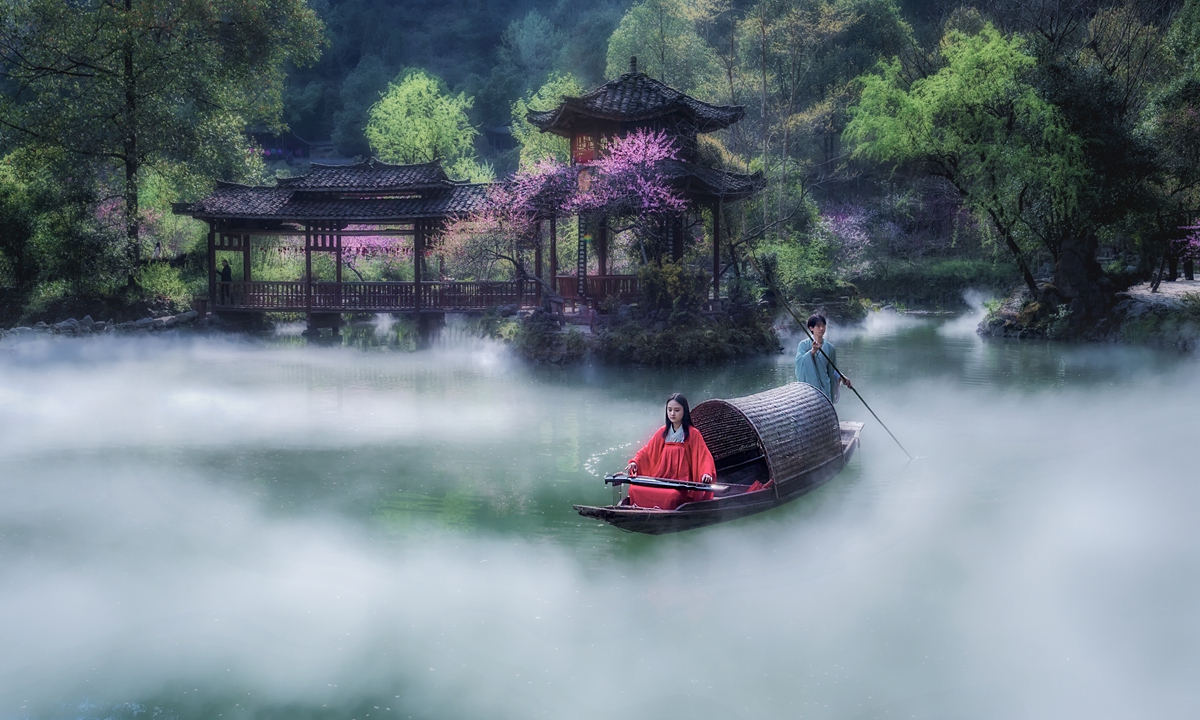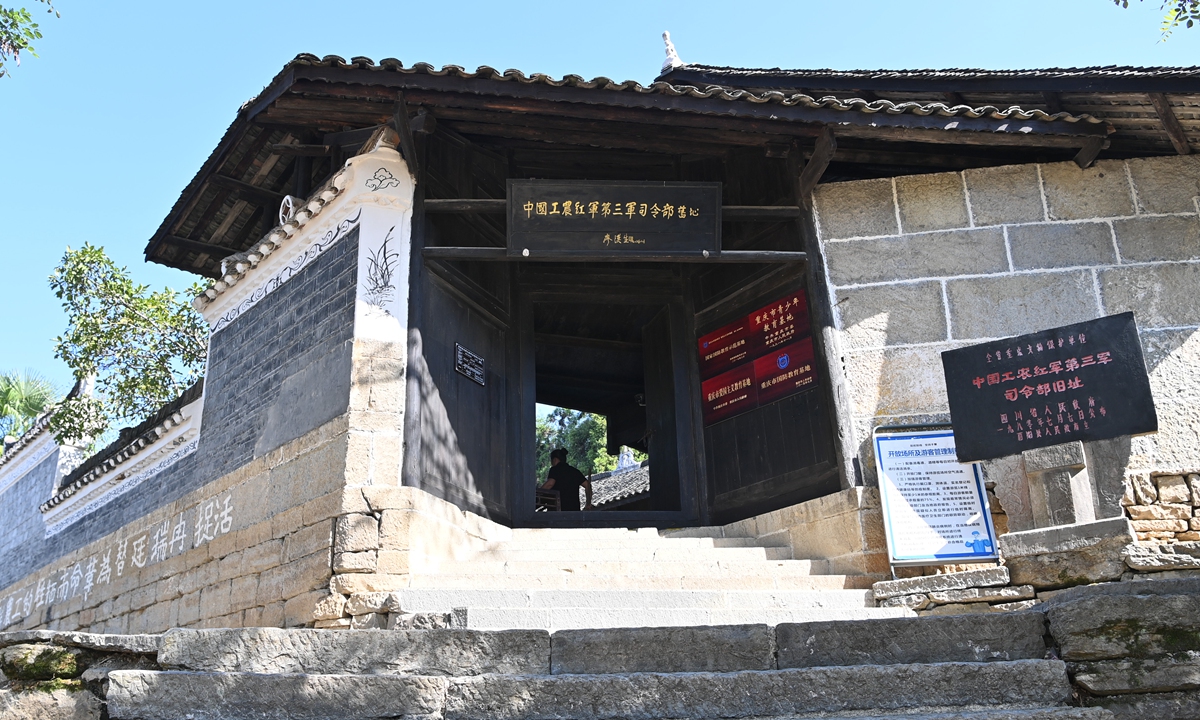
The Peach Blossom Spring scenic area in Tujia-Miao Autonomous County of Youyang in Chongqing Photos: Courtesy of the culture and tourism development committee in Tujia-Miao Autonomous County of Youyang
While the fourth national cultural relics census was underway, I made my first visit to the picturesque Tujia-Miao Autonomous County of Youyang in Southwest China's Chongqing Municipality.
Steeped in a rich historical background, Youyang is home to various ethnic minorities, including the Tujia and Miao peoples. In this region, two places carry distinct historical and cultural significance - the Taohuayuan (
Peach Blossom Spring) scenic area and the Nanyaojie Revolutionary Base Site.
The
Peach Blossom Spring scenic area appears like a real-life utopia straight from the pages of Chinese poet Tao Yuanming's
Peach Blossom Spring, attracting countless visitors with its unique natural scenery and profound cultural heritage. Stepping into the Nanyaojie Revolutionary Base Site, one can feel an enduring red legacy, experience the bravery of the Red Army, and witness the perfect integration of red culture with rural tourism.
A staff member of the local culture and tourism bureau told me that with the increase of "China travel" interest prompted by the new visa-free policy, an increasing number of foreign visitors, especially from Southeast Asia, are coming to Youyang to experience a place that combines natural beauty, historical culture, ethnic traditions, and modern tourism development.
A real-life utopiaBefore I entered the scenic area, I noticed the slogan "There are two Peach Blossom Springs in the world, one in your heart and one in Chongqing Youyang," which sparked a deep sense of curiosity in me.
Stepping into the scenic spot felt like a journey back in time to the Jin Dynasty (265-420), just as described by Tao Yuanming, "The land was broad and flat, with houses neatly arranged, surrounded by fertile fields, beautiful ponds, mulberry trees, and bamboo."
As I walked into a vast cave, I heard a melodious tune echoing from afar. Through the trees, I saw a man in traditional attire playing a song close to a large artificial moon. Our guide informed me he was playing a leaf song, music played using leaves as musical instruments, filling me with admiration for this ancient Chinese tradition expressed through music.
Under the vast cavern ceiling, I saw several crystal-clear lakes, said to have been formed by the water falling from the mountains above.
As I was about to exit the cave, a small stream flowed down the rocks, and next to it, a middle-aged woman dressed in the traditional ethnic attire of the region was mimicking the ancient method of washing clothes - beating them with a wooden bat.
Emerging from the cave I was greeted by the sudden brightness of the sun. In a clear small lake, a man dressed in traditional garments was rowing a boat, surrounded by a flock of geese, with mountains looming in the background.
Nestled against the mountains and waters, it was truly a delightful and serene scene. Every scenic spot was decorated with poems and quotes from
Peach Blossom Spring inscribed on walls and rocks. Courtyards, farmhouses, and trickling streams... Everything seemed to transport me to another world, allowing me to bask in the peaceful atmosphere of this timeless haven.
Upon reaching the exit of scenic spot, I glanced back. The world among those mountains looked like a dream, leaving memories blurring the line between the fantasy and reality.

The Nanyaojie Revolutionary Base Site in Tujia-Miao Autonomous County of Youyang
A symbol of red history
Another place that carries both the weight of history and the spirit of revolution is the Nanyaojie Revolutionary Base Site. A renowned symbol of red tourism, Nanyaojie is home to 56 revolutionary sites that once served as the stronghold of the third army of Chinese Workers' and Peasants' Red Army.
The site, now a revolutionary education base, showcased artifacts and exhibits, including the old beds, desks and pictures that told the story of the Red Army's bravery and sacrifice.
Walking through the preserved sites, I could almost hear the echoes of the past - the footsteps of the Red Army soldiers, the murmurs of strategy meetings, and the sounds of resilience in the face of adversity.
Wang Xingwang, a representative from the local cultural relics management office, told me that in recent years, the area has integrated red culture with rural tourism by excavating, organizing, and restoring these red resources, planning to develop a red tourism scenic area.
He added that during the fourth national cultural relics census, some new sites were discovered.
For instance, the former residence of the British missionary Rudolf Alfred Bosshardt during the Long March is located at Nanyaojie town. Originally built in the Qing Dynasty (1644-1911) period, the site covers an area of 180 square meters with a construction area of 150 square meters.
Bokeli, known in Chinese as Bo Fuli, stayed in the rightmost room of this house after arriving in Nanyaojie with the Sixth Corps of the Red Army in 1934.
In his book
The Restraining Hand: Captivity for Christ in China that was published in London, he wrote about his witnessing of a "great day" for the Red Army to meet, with tens of thousands of people gathering in the venue, and red flags fluttering. This is the first book on the Long March written by a foreigner who participated in the historical event.
"Bokeli witnessed some historical moments and was one of the first to present the Red Army's presence in Youyang to the Western world, leaving behind invaluable historical materials,"said Wang.
His excitement was palpable as he spoke of these new discoveries, which add a significant layer to the already rich tapestry of history in Youyang.





